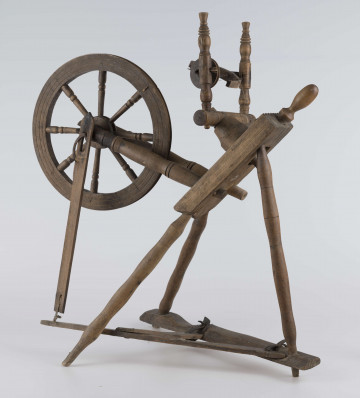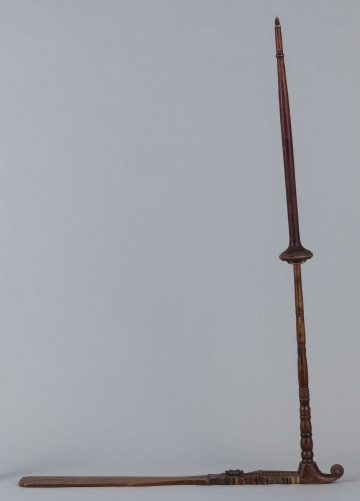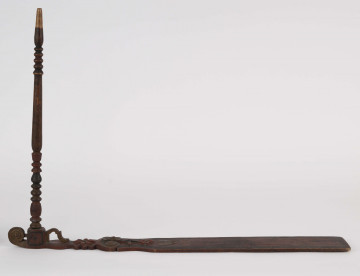
Horizontal spinning wheel
1901 — 1920
National Museum in Lublin
Part of the collection: Folk craft of the Lublin Region (19th/20th c.)
The spinning wheel from Zemborzyce dates to the beginning of the 20th century and was used for spinning thread. Linen or hemp yarn was fixed on a spindle, from which a thin thread was pulled out with the left hand, twisted in the fingers and occasionally moistened with saliva or water, and then wound with the right hand on the spindle. The resulting threads were intended for weaving linen on looms. The distaff wheel consisted of three main parts: the squat, the feather and the spinning wheel. ‘Przysiadka’ was the lower part, which was sat on while working (74.5 cm long). It was a kind of narrow board with an angular end at one end and thickened at the other, with a hole for a quill, i.e., a vertical shaft (55 cm high), on which a movable spinning wheel was placed from above. Usually, woodcarvers made spinners from deciduous trees. Among others sycamore was valued for its hardness and light-yellow colour, beech and hornbeam for its strength and smooth processing. The best wood for making them was maple – strong, glossy and not requiring painting. The use of wood from thorns and pears resulted in a beautiful yellow colour. This distaff has a very simple form and no decorations. The most ornate spinning spans were made in the districts of Janów, Biłgoraj and Zamość. According to the custom adopted there, a beautifully decorated spinning spear was offered by the fiancé to his future wife. In the lower part, initials and the production date were engraved on the ‘przysiadka’. A daughter also received a distaff from her parents as a dowry.
This type of distaff is called ‘krężołkowa’ and was used throughout the country. At the turn of the 19th and 20th centuries, it displaced the earlier type, the so-called spinning distaff, which survived the longest in the north-eastern part of the Lublin area and was eventually replaced by spinning wheels, which proved to be more efficient. Eventually the use of distaff was discontinued in the post-war years.
Author / creator
Dimensions
cały obiekt: height: 55 cm
Object type
weaving equipment
Technique
planing
Material
wood
Creation time / dating
Creation / finding place
Owner
The National Museum in Lublin
Identification number
Location / status

1901 — 1920
National Museum in Lublin

1930
National Museum in Lublin

1928
National Museum in Lublin
DISCOVER this TOPIC
Castle Museum in Łańcut
DISCOVER this PATH
Educational path